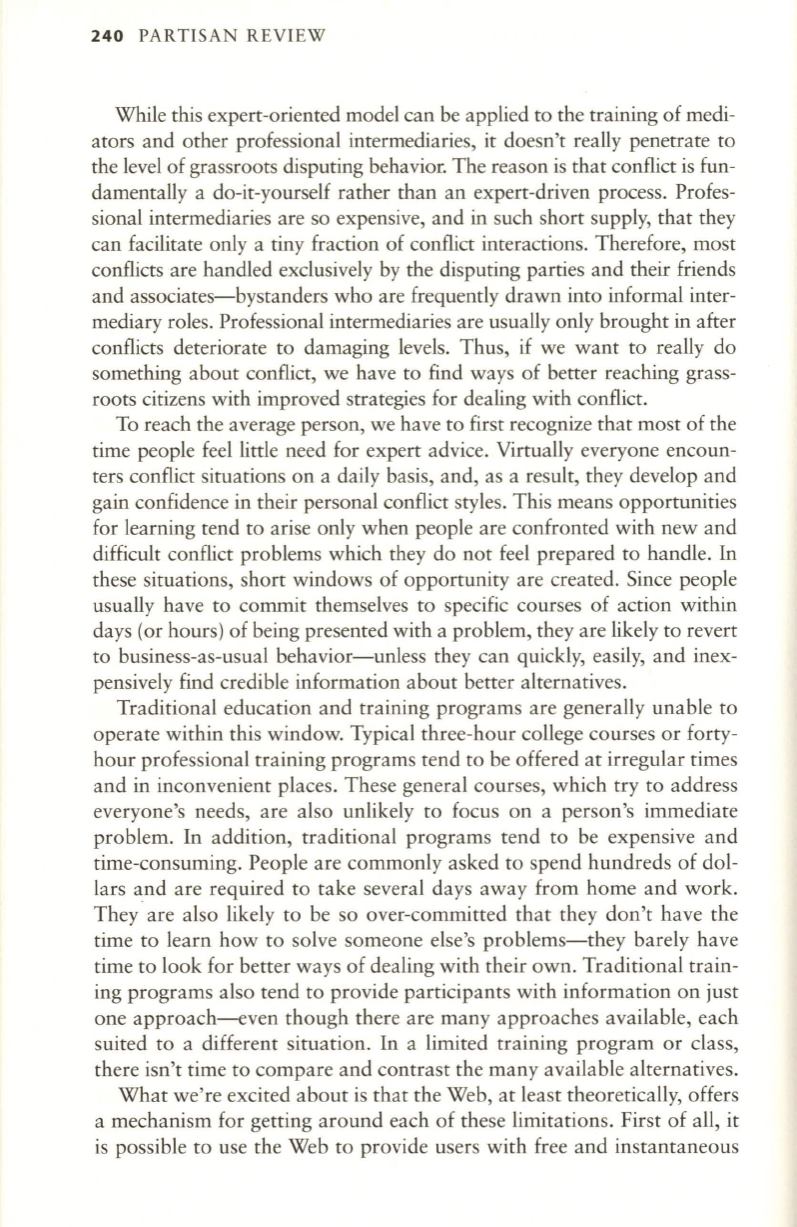
240
PARTISAN REVIEW
While this expert-oriented model can be applied
to
the training of medi–
ators and other professional intermediaries, it doesn't really penetrate to
the level of grassroots disputing behavior. The reason is that conflict is fun–
damentally a do-it-yourself rather than an expert-driven process. Profes–
sional intermediaries are so expensive, and in such short supply, that they
can facilitate only a tiny fraction of conflict interactions. Therefore, most
conflicts are handled exclusively by the disputing parties and their friends
and associates-bystanders who are frequently drawn into informal inter–
mediary roles. Professional intermediaries are usually only brought in after
conflicts deteriorate to damaging levels. Thus, if we want to really do
something about conflict, we have to find ways of better reaching grass–
roots citizens with improved strategies for dealing with conflict.
To reach the average person, we have
to
first recognize that most of the
time people feel little need for expert advice. Virtually everyone encoun–
ters conflict situations on a daily basis, and, as a result, they develop and
gain confidence in their personal conflict styles. This means opportunities
for learning tend to arise only when people are confronted with new and
difficult conflict problems which they do not feel prepared
to
handle. In
these situations, short windows of opportunity are created . Since people
usually have to commit themselves to specific courses of action within
days (or hours) of being presented with a problem, they are likely to revert
to
business-as-usual behavior-unless they can quickly, easily, and inex–
pensively find credible information about better alternatives.
Traditional education and training programs are generally unable to
operate within this window. Typical three-hour college courses or forty–
hour professional training programs tend
to
be offered at irregular times
and in inconvenient places. These general courses, which try to address
everyone's needs, are also unlikely
to
focus on a person's immediate
problem. In addition, traditional programs tend to be expensive and
time-consuming. People are commonly asked
to
spend hundreds of dol–
lars and are required to take several days away from home and work.
They ·are also likely to be so over-committed that they don't have the
time to learn how to solve someone else's problems-they barely have
time to look for better ways of dealing with their own. Traditional train–
ing programs also tend
to
provide participants with information on just
one approach-even though there are many approaches available, each
suited to a different situation. In a limited training program or class,
there isn't time
to
compare and contrast the many available alternatives.
What we're excited about is that the Web, at least theoretically, offers
a mechanism for getting around each of these limitations . First of all, it
is possible to use the Web to provide users with free and instantaneous


